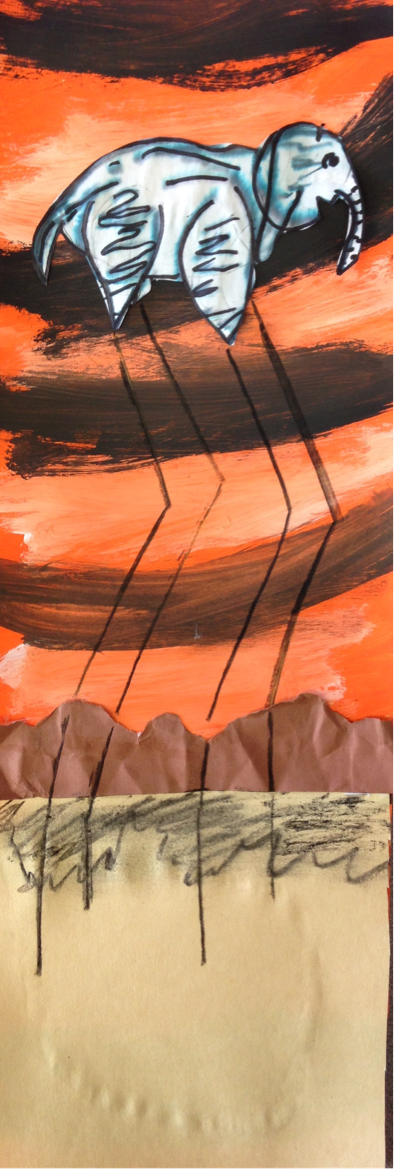|
2nd grade is learning about the Carnival of the Animals in music class with Mr. Kamp. The Carnival of the Animals is a series of songs about different animals. Mr. Kamp and I thought it would be fun to carry some of the animals that they are singing about over into my classroom. A lion is one of their songs so I thought learning about Henri Rousseau and his exotic lions would be a good project!
Henri Rousseau was a French Post-Impressionist painter who didn't take up painting until he was in his 40s. He is most well-known for his exotic depictions of jungles. However, Rousseau had never actually left France! He had nooooo idea what a jungle actually looked like! He would paint things that he saw in museums, books, and brochures. He would also paint the vegetation that was in his backyard. Because of this, his paintings are oftentimes inaccurate such as a lion in a jungle. In reality, lions do not live in jungles. Rousseau was often criticized by critics and other artists for producing "child-like" paintings. This was largely due to never having been taught how to paint, as well as painting things that he had never actually seen in person. We started off by learning how to draw the lion by breaking it down in simple shapes. Then we painted the lion a yellow-ish color. The next day we painted the eyes, ears, and nose using itty bitty bushes! We also learned how to dry-brush the lion's mane. Dry brushing is when you get just a little bit of paint on your brush. This leaves a "dry" look at the end of the brush stroke, perfect for the edge of our manes! The last day of the project, we outlined everything with a black crayon and glued down green leaves that I had pre-cut for the students.
0 Comments
Just like with our lions, we did this project because they are doing a song about elephants in Mr. Kamp's room. Loving the collaboration between our classes!
2nd grade learned about Surrealist artist, Salvador Dali. Dali was a really weird dude. Some people believe that he may have actually been insane. He is the most famous surrealist artist. This was an art movement that focused on showing things that were just tooooo strange to be true. Dali liked to paint things that he dreamt. And let's be frank, some pretty weird stuff can happen in your dreams. His most famous painting shows several limp, melted clocks. We focused on a painting of his that had elephants in it. While the elephants body looks normal, it is balanced on top of extremely long stilt-like legs. We started off by watching a video of an elephant drawing a picture of an elephant. I told them that if an elephant could do that, then they could too. We looked at how to break the elephant down into simple shapes and then drew it. We had to change the legs a bit so that we could make the long stilts later on in the project. After they hey finished drawing, we used a black washable marker to trace over our drawing. After tracing it, we brushed some water on to it. Because it was a water-based black marker, the black begins to spread and separate, turning it grayish and making the wrinkles look more realistic. We let it dry and then retraced the elephant again. For the background, we talked about warm colors which are colors that remind us of fire (red, yellow, and orange). These colors give our sky kind of an eerie feeling like Dali's. While our background was still wet, we lightly brushed white and black in spots to create a cloud streaked sky. This led us into the discussion of tints and shades. A tint is any color that has white mixed with it and a shade is any color that has black mixed with it. The he final day, we cut out the elephant and glued it on. We glued on a tan ground. Then we tore a brown strip of paper to create mountains. We crumpled our mountains up into a ball so that when we glued them down, they were wrinkled. This creates something called texture. Texture is how something feels or how it looks like it feels. Lastly, they used charcoal to add their stilt legs and a shadow to the mountains. This project was packed full of new art vocal for the kids! The students LOVED learning about Keith Haring. Mr. Haring was an American Pop Artist who was a prominent street artist during the 1980's. Artists are constantly striving to have their work seen by as many people as they can. The more widely seen the works are, the more likely the artist will make money and become famous. Keith Haring had a brilliant idea one day while riding the subway in New York City. In the subway, they would typically cover up old advertisements with large black sheets of butcher paper. He decided to start drawing on these black sheets of paper with chalk. Because the subway system is so popular, it allowed millions of people to see his drawings everyday. What Haring was doing though was illegal. He was arrested multiple times for his graffiti vandalism even though his drawings were only done in chalk. However, because his drawings brought happiness to so many people, he was willing to be arrested if it meant that people could see his work. He started to become more and more famous and began to be hired to paint murals in communities. As he became more famous, his work also became more expensive due to demand. He decided to open his own store called the Pop Shop where he sold shirts, buttons, prints, etc of his work for a low price. He believed that anyone should be able to see and own his work, not just the rich. His work is still highly recognized today and is especially well-known for his ability to show movement in his paintings. Our first day of the project, each table was given a large sheet of butcher paper based on their table color. One student from each table laid on the paper and the other students traced around them. Then, using their paper's complementary color (red and green, blue and orange, or purple and yellow), they painted in their figure. We had to put about 3 coats of paint on it. After painting a coat, I then had them do a little activity each class. The first class, I had taped up a bunch of black paper around my room. Students were given chalk and they could go around and draw 'graffiti' inspired my Haring's drawings. Haring's cartoonish drawings never had facial features and typically featured a bold black outlines and one solid color for the body. Another day, after adding another coat of paint, students played a game called 'Roll-A-Haring'. They were given a worksheet that had 6 different heads on it, 6 bodies, and 6 legs. Students would roll a die and the number would correspond to a head on the worksheet. They would then do it for the body and the head. They had a blast creating all different kinds of Haring-esque drawings. After getting a few coats of paint on our murals over several class periods, we added a bold black outline and then a bunch of crazy movement lines on the background.
|
Devon CalvertHarmony and Consolidated Elementary Art Teacher in Milton, WI. UW-Eau Claire graduate. WAEA President. Apple Teacher. Archives
March 2019
Categories
All
|














 RSS Feed
RSS Feed
